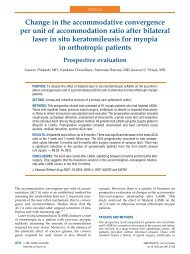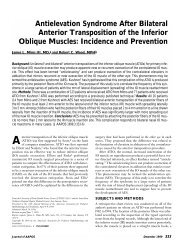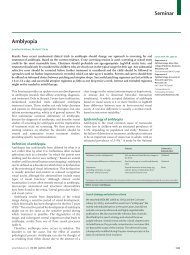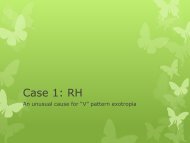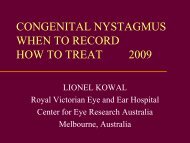What's new AAPOS 2008 - The Private Eye Clinic
What's new AAPOS 2008 - The Private Eye Clinic
What's new AAPOS 2008 - The Private Eye Clinic
You also want an ePaper? Increase the reach of your titles
YUMPU automatically turns print PDFs into web optimized ePapers that Google loves.
+/-0.08 and 0.34 +/-0.07 mm, for the S14, S24, S28 and TG100 needles, respectively<br />
(P=0.002, One way ANOVA). For both the S14 and S28 needles, there was a<br />
"statistically significant" P 0.05) linear trend of an increase in the depth of the pass as<br />
the length of the pass increased (P=0.01 for the S14 and P=0.02 for the S28). A similar<br />
trend was found with the S24 needle but the trend was not "statistically significant"<br />
(P=0.35). No such trend was found with the TG100 needle. CONCLUSIONS: Needle<br />
design had a definite impact on the characteristics of scleral tunnels created to simulate<br />
those made during strabismus surgery and may influence needle selection by the<br />
surgeon for different or various surgical circumstances, but the differences were not<br />
such as to predicate for or against the general use of any of these four needles for<br />
strabismus surgery.<br />
Essential infantile esotropia in neurologically impaired pediatric patients: is<br />
botulinum toxin better primary treatment than surgery?<br />
Hauviller V, Gamio S, Sors MV<br />
Binocul Vis Strabismus Q. 2007;22(4):221-6<br />
A prospective study was performed over a 10 year period on 25 children with infantile<br />
esotropia and neurological problems to answer this question. From November 1996 to<br />
March 2006 they were treated with injections of botulinum toxin (Botox) of both medial<br />
rectus muscles. Mean age was 26.4 months, (range 9-76 months) and mean initial angle<br />
was 35 prism diopters (PD)(range 20-60 PD). RESULTS: 18 patients (72%) remained<br />
orthotropic+/-10 PD at 29 months (range 6-59 months). Average number of injection<br />
treatments was 1.5 per patient. <strong>The</strong> authors compared their success rates with those<br />
obtained with primary conventional strabismus surgical procedures in 2 previously<br />
published series. Treatment with botulinum toxin seemed to produce better results than<br />
one surgical series and at least equally similar results to the other one. <strong>The</strong> authors<br />
advise that because there are other advantages to the injection procedure including<br />
superior safety and economy, they now use botulinum injections as the primary<br />
treatment in these patients.<br />
A comparison of hang-back with conventional recession surgery for exotropia.<br />
Orlin A, Mills M, Ying G-S, Liu C.<br />
J <strong>AAPOS</strong>. 2007; Dec 11(6);597.<br />
Retrospective review of 55 pts having surgery by a single surgeon between 200-2006 for<br />
comitant exotropia by either hang-back suspension loop or conventional surgery. Per<br />
the authors, the hang-back technique has better exposure, shorter preceduer duration<br />
21



